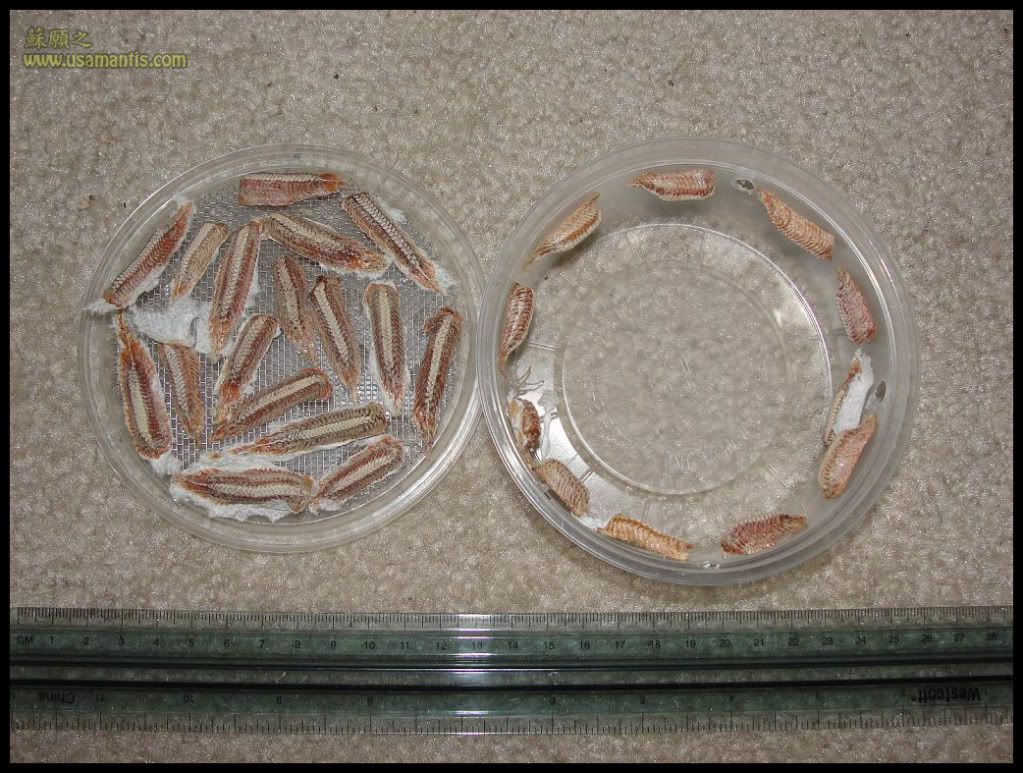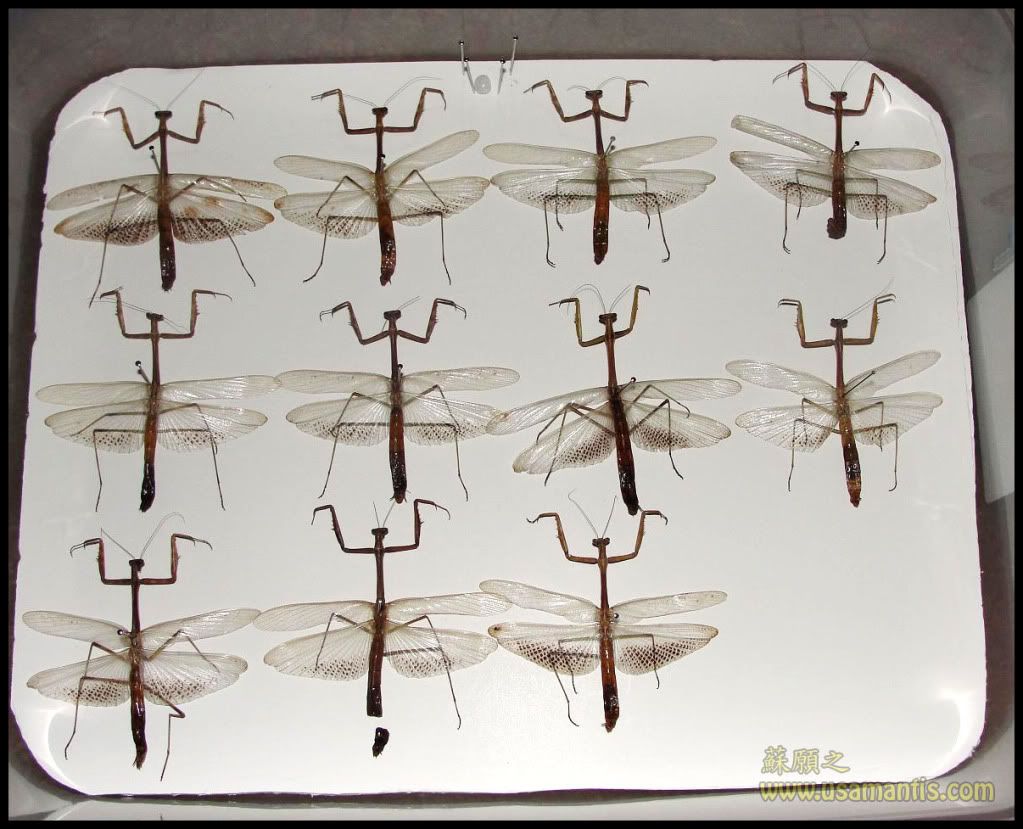There is this Orthoptera, Mantidae by E. Giglio-Tos (1927) that has keys for most mantis species around the world, it doesn't has the keys for all 20 Stagmomantis species (In fact the only US Stagmomantis sp I can find in the book is S. carolina), does the key still valid for the other species in this genus?There is no key. This genus is in a horrible state, with about 20 species.
You are using an out of date browser. It may not display this or other websites correctly.
You should upgrade or use an alternative browser.
You should upgrade or use an alternative browser.
So this the one?!?! the 'elusive' Larger Florida mantis?
- Thread starter yen_saw
- Start date

Help Support Mantidforum:
This site may earn a commission from merchant affiliate
links, including eBay, Amazon, and others.
[email protected]
Well-known member
[SIZE=14pt]hey Yen cool pics cool find man.[/SIZE]
No. Giglio-Tos unnecessarily splitted Stagmomantis into 5 genera or so, and produced a lot of synonyms (e.g. Stagmomantis nordica for dark carolina). Using that key is very difficult, and some species are missing which they were described later.There is this Orthoptera, Mantidae by E. Giglio-Tos (1927) that has keys for most mantis species around the world, it doesn't has the keys for all 20 Stagmomantis species (In fact the only US Stagmomantis sp I can find in the book is S. carolina), does the key still valid for the other species in this genus?
Thanks ArkBlue.[SIZE=14pt]hey Yen cool pics cool find man.[/SIZE]
Thanks. I was wondering about S. nordica too. I thought some of them are useful although very old publication, but as you said some species name have been revised afterwards. Unfortunately over here in the US, Stagmomantis sp study were mainly conducted by James Rehn and Morgan Hebard and those publication are very old as well.No. Giglio-Tos unnecessarily splitted Stagmomantis into 5 genera or so, and produced a lot of synonyms (e.g. Stagmomantis nordica for dark carolina). Using that key is very difficult, and some species are missing which they were described later.
This is the best description I could find. It is out of "Technical Bulletin #93". Alas, I only kept the pages regarding mantids in AZ, so I can not give any sitation info.
"Stagmomantis gracilipes Rehn. A rare mantis, closely resembling others of the genus. Female usually yellow or golden; male brown or green. It is best distinguished by the long, slender legs and pronotum: male, body, 58mm.; pronotum, 19.5mm.; front femur, 13.1mm.; hind femur, 16.5mm. Female, body, 61mm.; pronotum, 21mm.; front femur, 17mm.; hind femur, 19mm. Adults, early, june 12 to July 17."
"Stagmomantis gracilipes Rehn. A rare mantis, closely resembling others of the genus. Female usually yellow or golden; male brown or green. It is best distinguished by the long, slender legs and pronotum: male, body, 58mm.; pronotum, 19.5mm.; front femur, 13.1mm.; hind femur, 16.5mm. Female, body, 61mm.; pronotum, 21mm.; front femur, 17mm.; hind femur, 19mm. Adults, early, june 12 to July 17."
Rehn & Hebard did a good job, only sometimes they engaged too much in detail, loosing track of important features distinguishing species. But their work is very accurate and the figures are fantastic. What a pity that genital preparations weren't done at that time!
Last edited by a moderator:

$11.74 ($0.02 / Count)
Predator Foods Bulk Live Mealworms - 500 Count (Medium - 0.5")
Predator Foods

$39.95 ($1.25 / Ounce)
Creation Cultivated 32oz Fruit Fly Culture - Live Feeder Insects for Praying Mantis, Jumping Spiders, Geckos, Lizards, Dart Frogs (Drosophila Hydei Flightless)
Creation Cultivated

$13.19 ($13.19 / Count)
Butterfly Breeding Net Folding Butterfly Habitat Cage White Butterfly Mesh Cage for Kid Garden Science Education Tool 40x40x60cm Butterfly Cage
Hubeichunliangnongyefazhanyouxiangongsi

$18.50
Praying Mantis Egg Case With Hatching Habitat Cup- 2 Praying Mantids Egg Cases
NaturesGoodGuys

$34.99
$39.99
RESTCLOUD 30" Large Monarch Butterfly Habitat Cage, Outdoor Insect Mesh Cage Terrarium 16.5" x 16.5" x 30"
Restcloud

$20.99 ($20.99 / Count)
Jumping Spider Enclosure (4.7"x3.9"x7.8"), Spider Terrarium, Praying Mantis Habitat, Suitable for Small Arboreal Reptiles, Mantises, Spiders, and Other Invertebrates
Jiara Electronics

$13.99 ($223.84 / lb)
Surmen Legacy Freshly Started Wingless Drosophila Melanogaster Fruit Fly Culture
Surmen Legacy

$13.99 ($0.44 / Ounce)
Fresh Fruit Fly Culture (Drosophila Hydei) - Praying Mantis Mantid Frog Lizard Food - 32oz Cup
Surmen Legacy

$3.19 ($42.53 / lb)
$6.09 ($81.20 / lb)
Fluker's Gourmet Canned Food for Reptiles, Fish, Birds and Small Animals, Black, Mealworms 1.23 Ounce (Pack of 1)
Amazon.com

$18.99 ($2.12 / Ounce)
Josh's Frogs Producing Wingless Drosophila Melanogaster Fruit Fly Culture
Josh's Frogs

$16.99 ($16.99 / Count)
Josh's Frogs Freshly Started Flightless Drosophila Hydei Fruit Fly Culture
Josh's Frogs

$13.53
Butterfly Breeding Net, Folding Butterfly Habitat Cage White Butterfly Mesh Cage for Kid Garden Science Education Tool 40x40x60cm
enshishiqiannanwangluoyouxiangongsi
brancsikia
Well-known member
the fantastic site with the largest collection of Mantodea pictures seems to be back:Yeah. The Terra Typica site seems to be gone for ever...
Terra Typica Mantodea database
Cheers and enjoy!
now
Last edited by a moderator:
I get the header but clicking on the links does nothing.the fantastic site with the largest collection of Mantodea pictures seems to be back:Terra Typica Mantodea database
Cheers and enjoy!
cloud jaguar
Well-known member
Pelle
Well-known member
Pelle
Well-known member
Hmm.. Try this
http://www.terra-typica.ch/
Then go to SpeciesDatabase >> MANTODEA (Blätter-Modus) >> Show matching organisms
That should work
http://www.terra-typica.ch/
Then go to SpeciesDatabase >> MANTODEA (Blätter-Modus) >> Show matching organisms
That should work
MantidLord
Well-known member
Haha, thanks a lot.Hmm.. Try thishttp://www.terra-typica.ch/
Then go to SpeciesDatabase >> MANTODEA (Blätter-Modus) >> Show matching organisms
That should work
Question: is there a specific reason why two Mantis religiosa adult females would have such a noticeable difference in size (the first pic on Mantis religiosa)? I ask because when I had my females, one was a monster compared to the other two, who were of normal size. And yes, all were found in the same general area.
Last edited by a moderator:
kamakiri
Well-known member
The last two pages (just testing the links) worked for me.Hmm.. Try thishttp://www.terra-typica.ch/
Then go to SpeciesDatabase >> MANTODEA (Blätter-Modus) >> Show matching organisms
That should work
http://ttwebbase.dyndns.org/mantid/browse....?order=Mantodea
http://ttwebbase.dyndns.org/mantid/list.html
I have the same thing with tenedora angustipennis. Captive bred is tiny compared to wild caught. Could also be differences based on location.Haha, thanks a lot.Question: is there a specific reason why two Mantis religiosa adult females would have such a noticeable difference in size (the first pic on Mantis religiosa)? I ask because when I had my females, one was a monster compared to the other two, who were of normal size. And yes, all were found in the same general area.
sbugir
Well-known member
Mhm, my wild Chinese male was larger than my captive female. It sucked.I have the same thing with tenedora angustipennis. Captive bred is tiny compared to wild caught. Could also be differences based on location.
Last edited by a moderator:
MantidLord
Well-known member
Even though both were caught in the wild and raised to an adult? Though the larger one was caught at a sub-adult and the other two were caught a couple of molts before adulthood. I guess that makes since.Mhm, my wild Chinese males was larger than my captive female. It sucked.
Nothing from me yet. I leave most of the oothecae overwintering right now. My guess is the hatching pattern is similar to other Stagmomantis sp. where oothecae in the wild start to hatch only next Spring. I agree with you on the waiting part.Has anyones larger florida mantid ooths hatched yet? I have them and I hate waiting!

All the males are now on display tray....
































